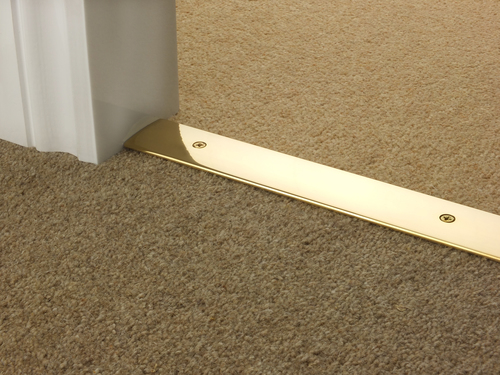How to Easily Seal Any Exterior Door Threshold in Your Home
Sealing your external door’s threshold is essential to keeping your home secure. As well as preventing leaks, draughts, and pests, sealing your threshold also protects your door from harsh natural elements such as rain, UV exposure, and extreme temperatures. Our team have compiled 3 simple methods to ensure your home is fully protected.
3 Simple Methods to Seal and Protect Your External Door Threshold
When looking to seal your external door threshold, there are 3 simple DIY approaches you can take:
Sealing a Door Threshold Using Caulking
- First, wipe down your threshold so it is clean of any dirt or residue. Make sure the weather is dry on the day you’re working.
- Use masking tape to cover the edge of the threshold for protection and to ensure clean lines.
- Using either a caulking gun or tube nozzle (depending on which caulk you are using), slowly apply a consistent bead of caulking along the gap between the threshold and the surface. If you see any holes or air bubbles, make sure to fill them in.
- Using a wet cloth, wipe from one end of the caulking to the other to create an air-tight seal.
- Repeat this process for any sides of your threshold that need sealing, inside and outside.
- Remove the masking tape.
- Finally, wait for the sealant to fully cure.


When sealing exterior door thresholds, it is important to consider what type of caulking you are using. It needs to be one that can withstand harsh outdoor conditions and is highly water-resistant, therefore it is best to find caulking that is either 100% silicone or made with polyurethane to extend the longevity of your seal.
Sealing a Door Threshold Using Expanding Foam
If you have a larger gap to seal beneath your door’s threshold, expanding foam is a great option. Follow the same process as with the caulking, but be careful not to overfill your gap as the sealant will expand. It is also important to choose a waterproof option, such as Gorilla Filler Weatherproof Expanding Foam, so it is effective against external factors.
Sealing a Door Threshold Using a Threshold Seal Strip
Some larger gaps may be too wide for caulking, and expanding foam could look too messy. In this instance, a threshold seal strip is a great solution. A threshold seal strip is typically made from metal or rubber and slots into the gap beneath your threshold. Seal strips are easily fitted by applying a bead of fixing adhesive beneath the strip before slotting the strip into place and waiting for it to set.
What’s the Best Sealing Method for My Door?
When looking to seal your door thresholds, certain approaches work best for different door styles and materials.
Sealing a Door Threshold to Concrete
If your door threshold is being sealed to concrete, remember that not all sealants and adhesives will attach to it. When choosing your product, make sure it can work with concrete, such as the Soudaflex Polyurethane Sealant.
Sealing Doors of Different Materials
uPVC Threshold: When sealing a uPVC door threshold, make sure the caulking you use is compatible with this type of plastic, such as DOWSIL Neutral Silicone.
Wooden and Metal Thresholds: For these materials, use wood or metal-compatible caulk such as UniBond Outdoor Window & Door Frame Caulk. If you are concerned about the aesthetic of the sealant matching your door threshold, you can either choose a coloured caulk or one that can be painted once cured, such as Ever Build External Frame Sealant.
Composite Door: Composite doors typically have a timber core that is surrounded by other materials such as uPVC, GRP, or another type of plastic. If you are sealing your composite door threshold, make sure you know what material your door is made from so you can choose an appropriate sealant.
Sealing Different Door Styles
French Doors: Expanding foam is a great option for sealing the threshold on your French doors. Just make sure to use a lower expansion foam sealant that is specific to doors, such as Soudal Soudafoam Window & Door, as it will expand a little less and prevent bowing of the threshold, which could otherwise affect the door’s ability to close properly.
Sliding Doors: Sliding door thresholds are typically more flush with the floor, so in this instance using caulking to cleanly seal the door’s threshold would be your best option. When doing this, you will need to be very careful not to get any caulking on the railing itself, or it could hinder the door’s ability to open and close smoothly.
Choosing the Best Solution
What method you use is ultimately up to you. When deciding, consider both the style and material of your door, as well as the surrounding surfaces and gaps. Keep in mind that you will likely need to find surface-specific materials to ensure your threshold seal is airtight and watertight.

Do You Need to Seal Internal Door Thresholds?
As internal door thresholds are not subject to natural elements such as rain and UV exposure, they do not need to be secured through sealing. One of the benefits of internal thresholds being secured with screws and nails is that it is much easier to swap them out if you want to mix things up and try a new threshold style. If you are looking for help on how to fit your internal door thresholds, here is a simple step-by-step guide.
If it’s time for a style refresh in your home, explore our extensive range of door thresholds here.


